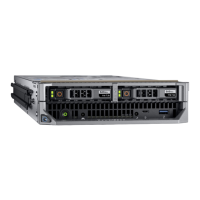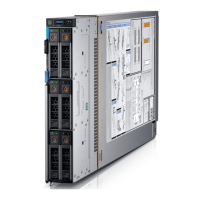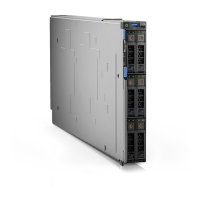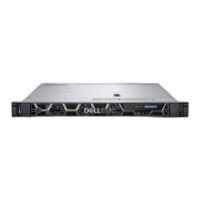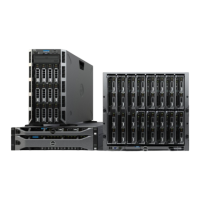Do you have a question about the Dell PowerEdge M630 and is the answer not in the manual?
Details the various hardware configurations supported by the Dell PowerEdge M630 system.
Describes the components and features located on the front panel of the M630 blade.
Provides the physical dimensions of the Dell PowerEdge M630 chassis.
Details the weight specifications for the Dell PowerEdge M630 chassis.
Outlines the supported Intel Xeon processor families and related specifications.
Specifies the type of system battery used in the PowerEdge M630.
Details the supported memory types, capacities, speeds, and configurations.
Lists the supported Dell PowerEdge RAID controller models.
Describes the PCIe mezzanine card slots and supported mezzanine cards.
Specifies the types and configurations of supported hard drives.
Details the specifications for supported Solid State Drives (SSDs).
Describes the supported optical drive options for the system.
Details the supported flash drive options for the system.
Provides information on the system's ports and connectors.
Details the specifications and types of USB ports on the system.
Describes the features of the internal dual SD module.
Outlines the specifications for the integrated video controller.
Lists the environmental operating and storage specifications.
Defines limitations for particulate and gaseous contamination to prevent damage.
Details the expanded operating temperature ranges and conditions.
Lists restrictions and conditions for operating the system in expanded temperature ranges.
Step-by-step guide for setting up the PowerEdge M630 system.
Information on configuring the Integrated Dell Remote Access Controller (iDRAC).
Describes methods for setting up the iDRAC IP address for network communication.
Resources and methods for installing a supported operating system.
Explains different methods for downloading system firmware and drivers.
Details on configuring BIOS, iDRAC, and device settings before OS boot.
Procedure to access and navigate the System Setup screen.
Information on accessing and configuring system BIOS settings.
Interface for setting up and configuring iDRAC parameters via UEFI.
Options to configure various device parameters within the system.
Capabilities of the Dell Lifecycle Controller for system management.
Enables selection of boot options and diagnostic utilities.
Details the menu items available in the Boot Manager.
Information on Preboot Execution Environment (PXE) for network booting.
Essential safety guidelines to follow before performing component maintenance.
Prerequisites and steps to take before accessing internal components.
Prerequisites and steps to take after completing internal component maintenance.
Lists the necessary tools for performing component installation and removal.
Procedures for safely removing and installing a blade server.
Detailed steps for removing the blade from the enclosure.
Detailed steps for installing a blade into the enclosure.
Information on the system cover and its role in security and airflow.
Step-by-step guide to remove the system cover.
Step-by-step guide to install the system cover.
Details on the cooling shroud for airflow management.
Procedure for removing the cooling shroud.
Procedure for installing the cooling shroud.
Purpose and use of processor and DIMM blanks for system cooling.
Steps to remove processor or DIMM blanks.
Steps to install processor or DIMM blanks.
Information on DDR4 RDIMMs and LRDIMMs supported by the system.
Recommended guidelines for installing memory modules for optimal performance.
Procedure for safely removing memory modules.
Procedure for safely installing memory modules.
Details on optional mezzanine cards and their installation.
Guidelines for installing mezzanine cards into the blade.
Procedure for removing a mezzanine card.
Procedure for installing a mezzanine card.
Information on the optional Internal Dual SD Module (IDSDM).
Steps to replace an SD card in the IDSDM.
Information on the internal USB connector for memory keys.
Procedure for replacing the internal USB memory key.
Steps to remove the optional IDSDM card.
Steps to install the optional IDSDM card.
Information on the optional rSPI card for storing system information.
Procedure for removing the optional rSPI card.
Procedure for installing the optional rSPI card.
Information on the SD vFlash card for local storage and deployment.
Steps to replace the SD vFlash card.
Details on the Network Daughter Card (NDC) for network connectivity options.
Procedure for removing the Network Daughter Card.
Procedure for installing the Network Daughter Card.
Information on supported processors and related installation procedures.
Steps to remove the processor heat sink.
Procedure for removing a processor from its socket.
Procedure for installing a processor into its socket.
Steps for installing a processor heat sink with thermal grease.
Details on supported hard drives and SSDs and their installation.
Procedure for removing a hard drive or SSD.
Procedure for installing a hard drive or SSD.
Steps to remove the hard drive or SSD cage assembly.
Steps to install the hard drive or SSD cage assembly.
Information on the hard drive or SSD backplane.
Procedure for removing the hard drive or SSD backplane.
Procedure for installing the hard drive or SSD backplane.
Information about the system board (motherboard).
Detailed steps for removing the system board.
Detailed steps for installing the system board.
Information on the Trusted Platform Module (TPM) for hardware security.
Procedure for installing the Trusted Platform Module (TPM).
Steps to initialize the TPM for BitLocker security features.
Steps to initialize the TPM for Intel TXT (Trusted Execution Technology).
Details on the NVRAM backup battery for retaining BIOS settings.
Procedure for replacing the NVRAM backup battery.
Information on storage controller cards and PCIe extender cards.
Procedure for removing PCIe extender or storage controller cards.
Procedure for installing PCIe extender or storage controller cards.
Overview of the Dell Embedded System Diagnostics (ePSA) utility.
Instructions on how to run the embedded system diagnostics.
Steps to run system diagnostics using external media.
Explanation of the controls and menus within the system diagnostics utility.
Details the settings and functions of system board jumpers.
Identifies and describes the connectors on the system board.
Procedure to disable system or setup passwords using jumpers.
Steps to troubleshoot issues related to system memory modules.
Procedure for diagnosing and resolving hard drive issues.
Steps to troubleshoot problems with USB devices.
Procedure for diagnosing and resolving Solid State Drive (SSD) issues.
Steps to troubleshoot issues with the internal SD card.
Steps to troubleshoot issues related to system processors.
Procedure for diagnosing and resolving system board issues.
Steps to troubleshoot issues with the NVRAM backup battery.
Information on how to contact Dell for support and service.
Using Quick Resource Locator (QRL) to access system information.
Details the various hardware configurations supported by the Dell PowerEdge M630 system.
Describes the components and features located on the front panel of the M630 blade.
Provides the physical dimensions of the Dell PowerEdge M630 chassis.
Details the weight specifications for the Dell PowerEdge M630 chassis.
Outlines the supported Intel Xeon processor families and related specifications.
Specifies the type of system battery used in the PowerEdge M630.
Details the supported memory types, capacities, speeds, and configurations.
Lists the supported Dell PowerEdge RAID controller models.
Describes the PCIe mezzanine card slots and supported mezzanine cards.
Specifies the types and configurations of supported hard drives.
Details the specifications for supported Solid State Drives (SSDs).
Describes the supported optical drive options for the system.
Details the supported flash drive options for the system.
Provides information on the system's ports and connectors.
Details the specifications and types of USB ports on the system.
Describes the features of the internal dual SD module.
Outlines the specifications for the integrated video controller.
Lists the environmental operating and storage specifications.
Defines limitations for particulate and gaseous contamination to prevent damage.
Details the expanded operating temperature ranges and conditions.
Lists restrictions and conditions for operating the system in expanded temperature ranges.
Step-by-step guide for setting up the PowerEdge M630 system.
Information on configuring the Integrated Dell Remote Access Controller (iDRAC).
Describes methods for setting up the iDRAC IP address for network communication.
Resources and methods for installing a supported operating system.
Explains different methods for downloading system firmware and drivers.
Details on configuring BIOS, iDRAC, and device settings before OS boot.
Procedure to access and navigate the System Setup screen.
Information on accessing and configuring system BIOS settings.
Interface for setting up and configuring iDRAC parameters via UEFI.
Options to configure various device parameters within the system.
Capabilities of the Dell Lifecycle Controller for system management.
Enables selection of boot options and diagnostic utilities.
Details the menu items available in the Boot Manager.
Information on Preboot Execution Environment (PXE) for network booting.
Essential safety guidelines to follow before performing component maintenance.
Prerequisites and steps to take before accessing internal components.
Prerequisites and steps to take after completing internal component maintenance.
Lists the necessary tools for performing component installation and removal.
Procedures for safely removing and installing a blade server.
Detailed steps for removing the blade from the enclosure.
Detailed steps for installing a blade into the enclosure.
Information on the system cover and its role in security and airflow.
Step-by-step guide to remove the system cover.
Step-by-step guide to install the system cover.
Details on the cooling shroud for airflow management.
Procedure for removing the cooling shroud.
Procedure for installing the cooling shroud.
Purpose and use of processor and DIMM blanks for system cooling.
Steps to remove processor or DIMM blanks.
Steps to install processor or DIMM blanks.
Information on DDR4 RDIMMs and LRDIMMs supported by the system.
Recommended guidelines for installing memory modules for optimal performance.
Procedure for safely removing memory modules.
Procedure for safely installing memory modules.
Details on optional mezzanine cards and their installation.
Guidelines for installing mezzanine cards into the blade.
Procedure for removing a mezzanine card.
Procedure for installing a mezzanine card.
Information on the optional Internal Dual SD Module (IDSDM).
Steps to replace an SD card in the IDSDM.
Information on the internal USB connector for memory keys.
Procedure for replacing the internal USB memory key.
Steps to remove the optional IDSDM card.
Steps to install the optional IDSDM card.
Information on the optional rSPI card for storing system information.
Procedure for removing the optional rSPI card.
Procedure for installing the optional rSPI card.
Information on the SD vFlash card for local storage and deployment.
Steps to replace the SD vFlash card.
Details on the Network Daughter Card (NDC) for network connectivity options.
Procedure for removing the Network Daughter Card.
Procedure for installing the Network Daughter Card.
Information on supported processors and related installation procedures.
Steps to remove the processor heat sink.
Procedure for removing a processor from its socket.
Procedure for installing a processor into its socket.
Steps for installing a processor heat sink with thermal grease.
Details on supported hard drives and SSDs and their installation.
Procedure for removing a hard drive or SSD.
Procedure for installing a hard drive or SSD.
Steps to remove the hard drive or SSD cage assembly.
Steps to install the hard drive or SSD cage assembly.
Information on the hard drive or SSD backplane.
Procedure for removing the hard drive or SSD backplane.
Procedure for installing the hard drive or SSD backplane.
Information about the system board (motherboard).
Detailed steps for removing the system board.
Detailed steps for installing the system board.
Information on the Trusted Platform Module (TPM) for hardware security.
Procedure for installing the Trusted Platform Module (TPM).
Steps to initialize the TPM for BitLocker security features.
Steps to initialize the TPM for Intel TXT (Trusted Execution Technology).
Details on the NVRAM backup battery for retaining BIOS settings.
Procedure for replacing the NVRAM backup battery.
Information on storage controller cards and PCIe extender cards.
Procedure for removing PCIe extender or storage controller cards.
Procedure for installing PCIe extender or storage controller cards.
Overview of the Dell Embedded System Diagnostics (ePSA) utility.
Instructions on how to run the embedded system diagnostics.
Steps to run system diagnostics using external media.
Explanation of the controls and menus within the system diagnostics utility.
Details the settings and functions of system board jumpers.
Identifies and describes the connectors on the system board.
Procedure to disable system or setup passwords using jumpers.
Steps to troubleshoot issues related to system memory modules.
Procedure for diagnosing and resolving hard drive issues.
Steps to troubleshoot problems with USB devices.
Procedure for diagnosing and resolving Solid State Drive (SSD) issues.
Steps to troubleshoot issues with the internal SD card.
Steps to troubleshoot issues related to system processors.
Procedure for diagnosing and resolving system board issues.
Steps to troubleshoot issues with the NVRAM backup battery.
Information on how to contact Dell for support and service.
Using Quick Resource Locator (QRL) to access system information.
| Tcase | 72.1 °C |
|---|---|
| Bus type | QPI |
| Stepping | R2 |
| Tjunction | - °C |
| FSB Parity | No |
| Idle States | Yes |
| Scalability | 2S |
| Processor code | SR206 |
| Processor cache | 20 MB |
| Processor cores | 8 |
| Processor model | E5-2630V3 |
| System bus rate | 8 GT/s |
| Processor series | Intel Xeon E5-2600 v3 |
| Processor socket | LGA 2011-v3 |
| Processor threads | 16 |
| Processor codename | Haswell |
| Motherboard chipset | Intel C610 |
| Number of QPI links | 2 |
| Processor frequency | 2.4 GHz |
| Processor cache type | Smart Cache |
| Configurable TDP-down | - W |
| Processor lithography | 22 nm |
| Processor manufacturer | Intel |
| Processor package size | 52.5 x 45 mm |
| Processor front side bus | - MHz |
| Processor boost frequency | 3.2 GHz |
| Processor operating modes | 64-bit |
| Graphics & IMC lithography | - nm |
| PCI Express configurations | x4, x8, x16 |
| Supported instruction sets | AVX |
| Thermal Design Power (TDP) | 85 W |
| Thermal solution specification | - |
| Maximum number of PCI Express lanes | 40 |
| Memory types supported by processor | DDR4-SDRAM |
| Memory voltage supported by processor | - V |
| Memory channels supported by processor | Quad |
| Memory clock speeds supported by processor | 1600, 1866 MHz |
| Memory bandwidth supported by processor (max) | 59 GB/s |
| Maximum internal memory supported by processor | 768 GB |
| On-board graphics card model | Not available |
| Processor ARK ID | 83356 |
| Intel Secure Key Technology version | 1.00 |
| Intel Identity Protection Technology version | 0.00 |
| Compatible operating systems | Windows Server 2008/2012 R2 Windows Server 2012 Windows Server 2008/2012 Datacenter Windows Server 2008 R2 SP1 Windows Server 2008 R2 SP2 Novell SUSE Linux Enterprise Server Red Hat Enterprise Linux |
| Chassis type | Blade |
| HDD size | 2.5 \ |
| HDD speed | 15000 RPM |
| HDD interface | Serial Attached SCSI (SAS) |
| Total storage capacity | 300 GB |
| Maximum storage capacity | - TB |
| Number of HDDs installed | 1 |
| Memory slots | 24x DIMM |
| Internal memory | 8 GB |
| Memory clock speed | 2133 MHz |
| Maximum internal memory | - GB |
| Cabling technology | 10/100/1000Base-T(X) |
| Ethernet interface type | Gigabit Ethernet |
| USB 2.0 ports quantity | USB 2.0 ports have a data transmission speed of 480 Mbps, and are backwards compatible with USB 1.1 ports. You can connect all kinds of peripheral devices to them. |
| Ethernet LAN (RJ-45) ports | 4 |
| VGA (D-Sub) ports quantity | 0 |
| PCI Express slots version | 3.0 |
| Operating altitude | 0 - 3048 m |
| Non-operating altitude | 0 - 12000 m |
| Storage temperature (T-T) | -40 - 65 °C |
| Operating temperature (T-T) | 10 - 35 °C |
| Storage relative humidity (H-H) | 5 - 95 % |
| Operating relative humidity (H-H) | 10 - 80 % |
| Depth | 544.3 mm |
|---|---|
| Width | 50.3 mm |
| Height | 192.3 mm |
| Weight | 6800 g |



